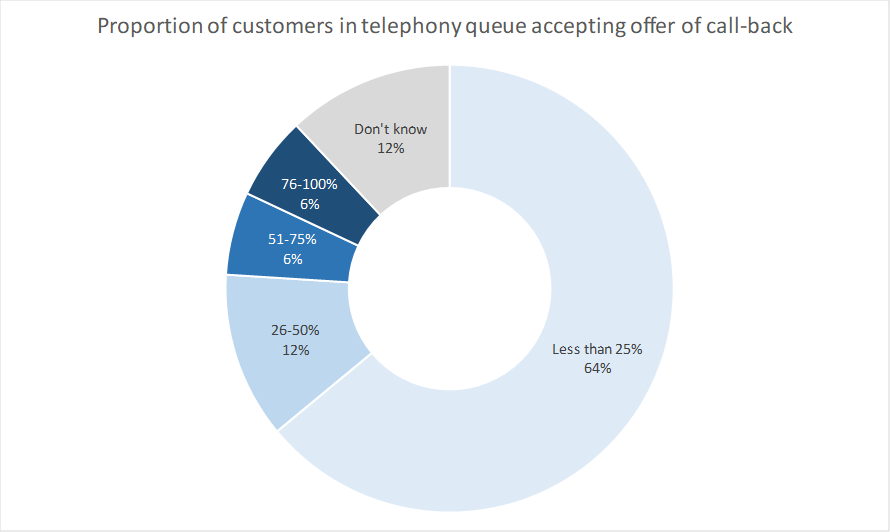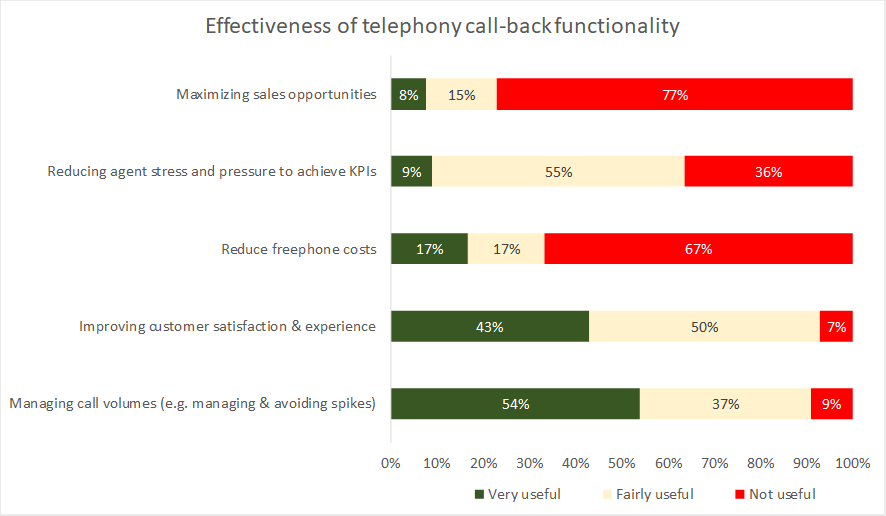Customers have such a dislike
of contact centre queuing that they cannot objectively estimate how long they
queue for – ContactBabel research shows that while 94% of UK contact centres
report an average speed to answer of under two minutes, 55% of customers report
that they normally wait for over five minutes before their calls are
answered.
Yet only 26% of UK contact centres offer the customers a call-back function, so as to alleviate call spikes while improving the customer experience.
Virtual queues
There are several
different varieties of virtual queuing (call-back) systems: the "First-In,
First-Out" (FIFO) system keeps the customer's place in line by monitoring
queue conditions until the estimated wait time hits a set target, at which
point it intercepts incoming calls before they enter the queue, informing
customers of the likely wait time and offering the option of receiving an
outbound call in the same amount of time as if they had personally waited on
hold.
At this point,
customers choosing to remain on hold go directly into a queue. Customers who
opt for a call-back are prompted to enter their telephone number and possibly
some extra details that can be used for agent selection and skills-based
routing, and are then asked to hang up. Virtual placeholders keep the
customers' places in line and the virtual queuing system launches an outbound
call to the customer at the agreed time. When the call-back is answered by the
customer, the system checks the right person is on the line and ready to talk.
If this is the case, the call is routed to the next available suitable agent,
who handles it as a normal inbound call.
By replacing real hold
time with this virtual version, customers are free to do other things, thus
removing four of the five problems that they have with queues - unknown queue
times, hold music, the inability to do anything else and repetitive
announcements.
Scheduled call-back
options differ from a FIFO experience, in that customers do not keep their
place in queue, but are called back at some time in the future that is more
convenient for them (for example, when they know they will be back at their
desk and available to take a call).
There are several
types of scheduled virtual queuing:
- Datebook-type
scheduling systems allow customers to schedule appointments for days in the
future, with times blocked-out that are unavailable for scheduling, and
limiting the number of call-backs available. This system also allows customers
that reach a contact centre out-of-hours to schedule a call-back during normal
working hours
- Timer
scheduling systems promise a call-back after a specific amount of time,
regardless of queue conditions. While this ensures an on-time call-back for the
customer, a surge in call volume or staff reduction due to a shift change can
create problems for the contact centre's queue, lengthening wait times for
other callers
- Forecast-based
scheduling systems offer appointments during times that are expected to have
low call volumes. These times may not be convenient for the customer, and the
contact centre runs the risk that their scheduling may be inaccurate.
Respondents offering a telephony call-back option were asked to state
which types of call-back were presented to callers. 65% of respondents that
offered call-back functionality allowed callers to request a FIFO call-back
(i.e. acting as a placeholder in the queue), with 35% allowing customers to
specify a scheduled time, 25% being called back at a time that suits the
contact centre, and 10% only allowing callers to specify a day to be called
back on.
Survey respondents who offered call-back reported that FIFO placeholder
call-backs were far more requested than one of the delayed call-back types. On
analysing the contact centre activity type (i.e. sales or service), those
callers making sales enquiries were more likely to want a placeholder-type of
call-back. This could possibly be explained by the differing states of mind of
customers calling to purchase something, or to make a query or payment. The
former is more likely to have chosen to call the contact centre to make a
purchase that they are enthusiastic about, and/or which is time-sensitive, and
as such, want to speak to the business as soon as possible.
Respondents indicate
that telephony call-back tends not to be universally available to callers, with
businesses only offering it after a certain period of wait time or once the
queue becomes so long that it triggers the functionality to be offered. Half of
respondents trigger call-back functionality based on the actual time that the
customer has spent waiting, with around 30% looking at the estimated wait time
based on ACD statistics. The remainder of respondents use a mixture of actual
and expected queue time.
Two-thirds of contact
centres using call-back state that it is offered after the caller has spent up
to two minutes in the queue, although 10% say that it takes longer than five
minutes before call-back is offered, at which point many customers have already
given up.
Of those who are offered
a call-back, most respondents report that fewer than a quarter of callers chose
this option. This may be because customers lack confidence that the business
will call back when they say they will, are relatively unfamiliar with the
technology and/or do not have the call-back option offered to them early enough
and so have already abandoned the call.

The previous finding is concerning, as call-back has great potential for
both customers and businesses: virtual queuing and call-back, when implemented
- and explained properly to customers - can be a win-win for both business and
customer by:
- Increasing
customer satisfaction and experience by being called back by an agent who
already understands the customer’s context and identity
- Reducing
average speed to answer and call abandonment rates
- Reducing
call lengths as customers should spend less time complaining and adding-on
unnecessary queries "while they're on...", pressuring agents trying
to meet targets
- Reducing
toll-free/freephone costs, as virtual queuing time does not incur telephone
charges borne by the business.
Respondents offering
telephony call-back functionality stated clearly that is was most useful for
managing call volumes and spikes in busy periods, thus improving customer
satisfaction and experience. Being able to spread calls out over the day and
allow callers to keep their place in the queue - without actually having to
queue – is seen by users as being of great use to both company and customer.
